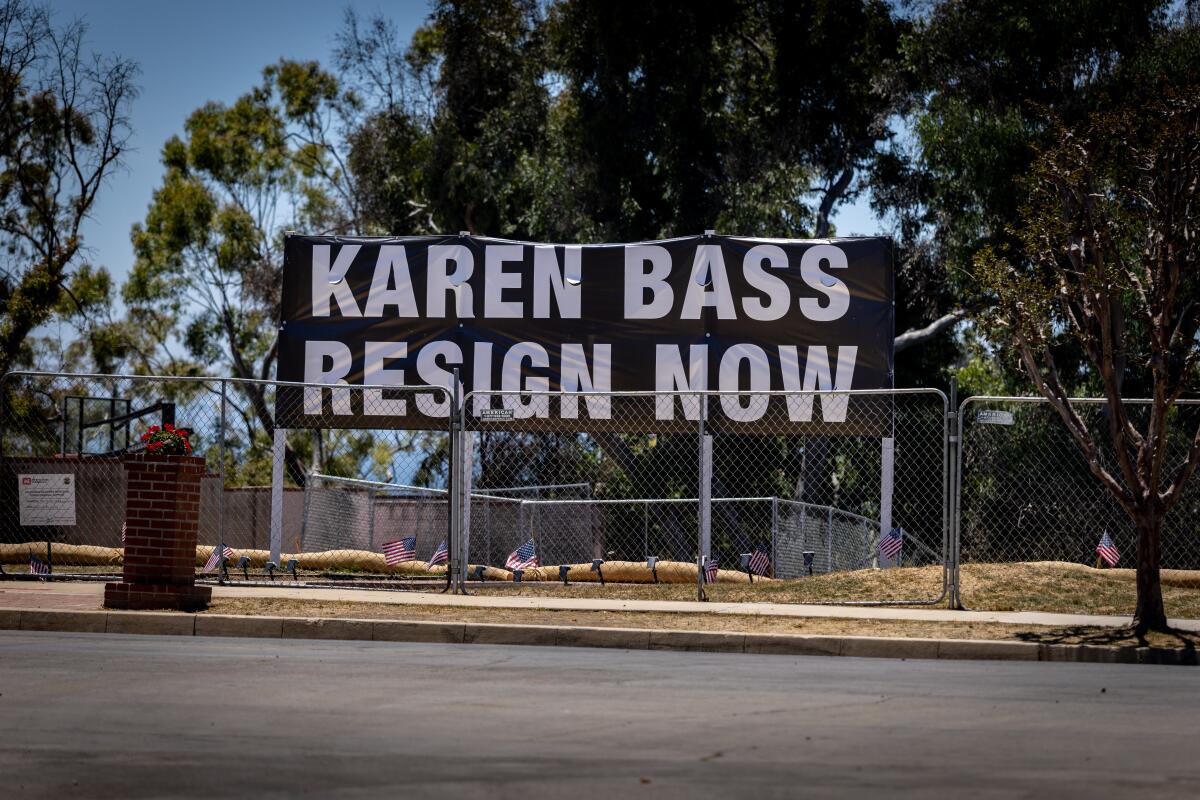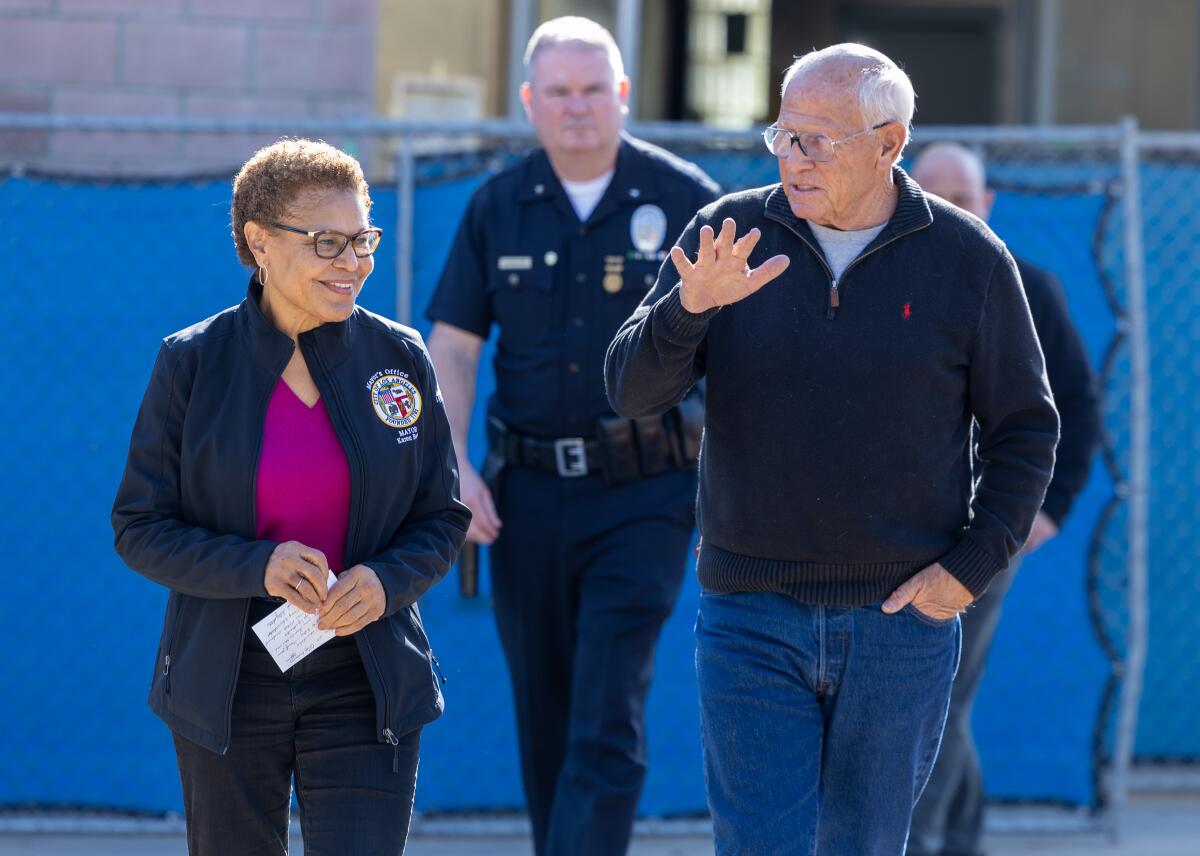Six months after the fire, has Mayor Karen Bass done enough for the Palisades?
Six months to the day that flames ravaged Altadena and Pacific Palisades, Mayor Karen Bass was preparing to mark the occasion alongside Gov. Gavin Newsom and other leaders.
But instead of heading north to the Pasadena news conference last week, the mayor’s black SUV made a detour to MacArthur Park, where a cavalcade of federal agents in tactical gear had descended on the heart of immigrant Los Angeles.
In a seafoam blue suit, Bass muscled her way through the crowds and could be heard on a live news feed pushing the agents to leave.
Ultimately, she sent an underling to join Newsom and U.S. Sen. Alex Padilla to discuss fire rebuilding and recovery, as she held an impromptu City Hall news conference decrying the immigration raid.
This is the delicate dance Bass has found herself doing in recent weeks. Recovering from one of the costliest natural disasters in American history remains a daily slog, even as a new and urgent crisis demands her attention.
The federal immigration assault on Los Angeles has granted Bass a second chance at leading her city through civic catastrophe. Her political image was badly bruised in the wake of the fires, but she has compensated amid a string of historically good headlines.
Killings have plummeted, with Los Angeles on pace for the lowest homicide total in nearly 60 years. Bass has also made progress on the seemingly intractable homelessness crisis for the second consecutive year, with a nearly 8% decrease in the number of people sleeping on city streets in 2024.
A “Karen Bass Resign Now” sign on Alma Real Drive on July 9 in Pacific Palisades.
(Jason Armond / Los Angeles Times)
But there is a widening gulf between Pacific Palisades, where the annihilation remains palpable as far as the eye can see, and the rest of the city, where attention has largely flickered to other issues. Amid her successes, the mayor still faces harsh critics in the wealthy coastal enclave.
“The mayor has been very clear that every day that families can’t return home is a day too long, and she will continue taking action to expedite every aspect of the recovery effort to get them home,” Bass spokesperson Zach Seidl said.
Bass was on a diplomatic trip to Ghana, despite warnings of severe winds, when the conflagration erupted in early January. She floundered upon her return, fumbling questions about her trip, facing public criticism from her fire chief (whom she later ousted) and appearing out of sync with other leaders and her own chief recovery officer.
Those initial days cast a long shadow for the city’s 43rd mayor, but Bass has regained some of her footing in the months since. She has made herself a fixture in the Palisades, even when the community has not always welcomed her with open arms, and has attempted to expedite recovery by pulling the levers of government. Her office also led regular community briefings with detailed Q&A sessions.
Bass issued a swath of executive orders to aid recovery, creating a one-stop rebuilding center, providing tax relief for businesses affected by the fires and expediting permitting. The one-stop center has served more than 3,500 individuals, according to the mayor’s office.
Felipe Ortega raises the California flag at Gladstones Malibu on July 2 in Malibu. After sustaining damage from the fire, Gladstones reopened for business earlier this month.
(Juliana Yamada / Los Angeles Times)
A number of restaurants and other amenities have also reopened in the neighborhood. The Starbucks on Palisades Drive is set to return later this month.
Bass frequently touts the Palisades fire recovery as the fastest in modern California history, though recent natural disasters don’t offer an apples-to-apples comparison.
Sue Pascoe, a Palisades resident who lost her home in the Via Bluffs neighborhood and helms a hyperlocal website called Circling the News, said the mayor has made some inroads.
“I think she’s tried very hard to repair relationships. She’s come up there a whole lot,” Pascoe said. “But I’m not sure it’s worked, to be honest with you.”
When Bass visits the Palisades, said Maryam Zar, head of the Palisades Recovery Coalition, residents tell her she has not done enough to hasten rebuilding.
“She always seems truly mind-boggled by that” accusation, Zar said. “She looks at us like, ‘Really? What have I not done?’”
The issue, in Pascoe’s view, is more about the limitations of the office than Bass’ leadership. Residents traumatized by the loss of their homes and infuriated by a broken insurance system and cumbersome rebuilding process would like to see the mayor wave a magic wand, slash red tape on construction and direct the full might of local government to reviving the neighborhood.
But Los Angeles has a relatively weak mayoral system, compared with cities such as New York and Chicago.
The mayor is far from powerless, said Raphael Sonenshein, executive director of the John Randolph Haynes and Dora Haynes Foundation and a scholar of local government. But he or she shares authority with other entities, such as the 15-member City Council and the five-member L.A. County Board of Supervisors.
“To move things in L.A., you always need mayoral leadership, combined with the cooperation, collaboration — or hopefully not opposition — of a lot of powerful people in other offices,” Sonenshein said. “And yet, the mayor is still the recognized leader. So it’s a matter of matching up people’s expectation of leadership with how you can put the pieces together to get things done.”
Take the issue of waiving permit fees.
Construction workers rebuild a home on July 9 in Pacific Palisades.
(Jason Armond / Los Angeles Times)
In February, City Councilmember Traci Park, who represents the fire-ravaged area, introduced a proposal to stop levying fees for permits to rebuild Palisades homes.
Pascoe and others cheered in late April when the mayor signed an executive order supporting Park’s plan.
But as Pascoe moved forward with rebuilding her longtime home, she was confused when her architect gave her a form to sign that said she would pay the city back if the City Council doesn’t move forward on the fee waivers.
As it turned out, Bass’ order did not cancel permit fees outright but suspended their collection, contingent on the council ultimately passing its ordinance, since the mayor can’t legally cancel the fees on her own.
Park’s proposal is still wending its way through the council approval process. Officials estimate that waiving the fees will cost around $86 million — a particularly eye-popping sum, given the city’s budget crisis, that may make approval difficult.
Apart from the limitations of her office, Bass has also confused residents and made her own path harder with a seemingly haphazard approach to delegating authority.
Mayor Karen Bass speaks at a discussion with local leaders and residents to mark 100 days since the start of the L.A. wildfires at Will Rogers State Beach on April 17.
(Carlin Stiehl / Los Angeles Times)
Within a month of the blaze, Bass announced the hiring of Hagerty Consulting as a “world-class disaster recovery firm” that would coordinate “private and public entities.” To many residents, Bass had appeared to give the firm the gargantuan task of restoring the Palisades.
In reality, Hagerty was retained as a consultant to the city’s tiny, underfunded Emergency Management Department, whose general manager, Carol Parks, is designated by city charter as the recovery coordinator. Bass also brought out of retirement another former EMD chief, Jim Featherstone, who has served as de facto recovery chief behind the scenes.
But based on Bass’ public statements, many Angelenos thought the recovery would be led by a familiar face — Steve Soboroff.
L.A. Mayor Karen Bass and her disaster recovery czar Steve Soboroff, left, talk to media during a news conference at the Palisades Recreation Center on Jan. 27 in Pacific Palisades.
(Brian van der Brug / Los Angeles Times)
Soboroff, a developer, civic leader and longtime Palisades resident, signed on for a three-month stint as chief recovery officer and was initially tasked with creating a comprehensive strategy for rebuilding. But his role was soon dramatically scaled back. When he left in mid-April, Soboroff said he had been shut out from high-level planning essentially from the start and spoke candidly about his issues with Hagerty.
The city brought in a headhunter before Soboroff left, but the position has now been unfilled for longer than Soboroff’s 90-day tenure. (Seidl said Wednesday that the city is “in the process of interviewing and thoroughly vetting qualified candidates,” though he did not set a timeline.)
In June, Bass shifted course again by tapping AECOM, the global engineering firm, to develop a master recovery plan, including logistics and public-private partnerships.
Yet Bass’ office has said little to clarify how AECOM will work with Hagerty, and at a public meeting last month, leaders of the Emergency Management Department said that they, too, were in the dark about AECOM’s scope of work.
“We don’t know a whole lot about AECOM other than their reputation as a company,” Featherstone said at the City Council’s ad hoc recovery committee.
Seidl said Wednesday that AECOM would be working in “deep coordination” with Featherstone’s department while managing the overall rebuilding process. The firm is responsible for developing an infrastructure reconstruction plan, a logistics planning in coordination with local builders and suppliers and a master traffic plan as rebuilding activity increases, he said.
Los Angeles Mayor Karen Bass, left, U.S. Sen. Alex Padilla and California Gov. Gavin Newsom tour the downtown business district of Pacific Palisades as the Palisades fire continues to burn on Jan. 8 in Los Angeles.
(Eric Thayer / Getty Images)
Hagerty, meanwhile, continues to work with EMD and has charged the city nearly $2 million thus far, Seidl said, most of which is reimbursable by the federal government.
Zar, head of the Palisades Recovery Coalition, said she was told to expect a meeting with AECOM more than a month ago, but that meeting has been delayed “week after week after week, for four or five weeks.”
“That organized recovery structure isn’t there, and that void is really creating space for Palisadians to be fearful, fight against each other, and be divided,” said Zar. “That our leaders and lawmakers have yet to come to the table with a plan is unforgivable.”
The work awarded to Hagerty, AECOM and another firm, IEM, which is assisting in federal reimbursements, prompted City Councilmember Monica Rodriguez to remark in June, “For a broke city, we find a lot of money to give out a lot of contracts.”
Bass’ 2022 mayoral opponent Rick Caruso has been a frequent — and very public — antagonist since the fires, questioning delays and taking other shots at the mayor.
Caruso’s Steadfast L.A., the nonprofit he launched to support fire victims, pushed for an artificial intelligence tool that could swiftly flag code violations in construction plans and trim permit processing times.
Steadfast representatives got buy-in from L.A. County. When they presented the tool to Bass’ team, they said they encountered general support but a plodding pace. Frustrated, Caruso reached out to Newsom, who, according to Caruso, quickly championed the technology, pushing the city to embrace it.
Bass’ spokesperson disputed the suggestion of delays, saying the mayor’s team has discussed technological innovations with Newsom’s office since February.
This week, L.A. County rolled out a pilot program in which fire survivors can use the AI plan-check tool. The city launched beta testing of the tool Wednesday.
The episode exemplified to Caruso why the recovery has moved slowly.
“There’s no decision-making process to get things done with a sense of urgency,” he said.


